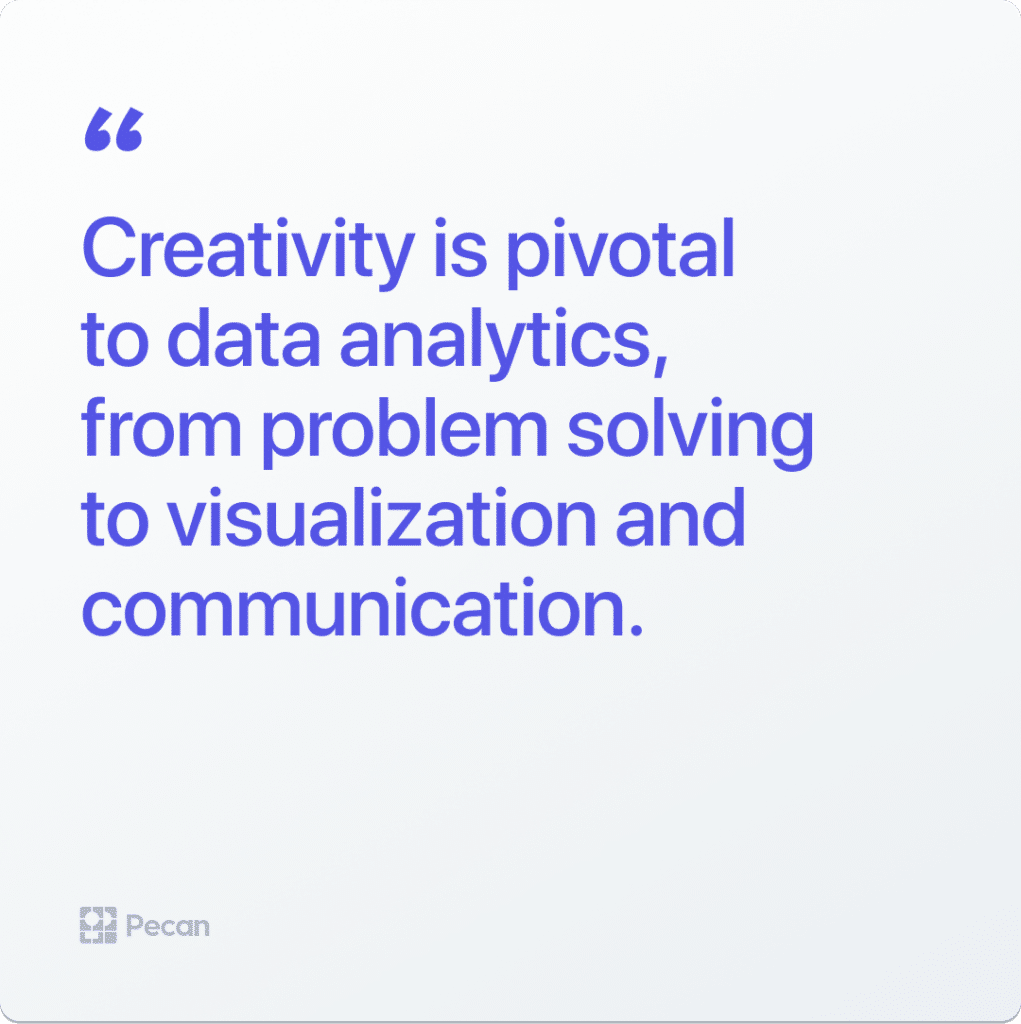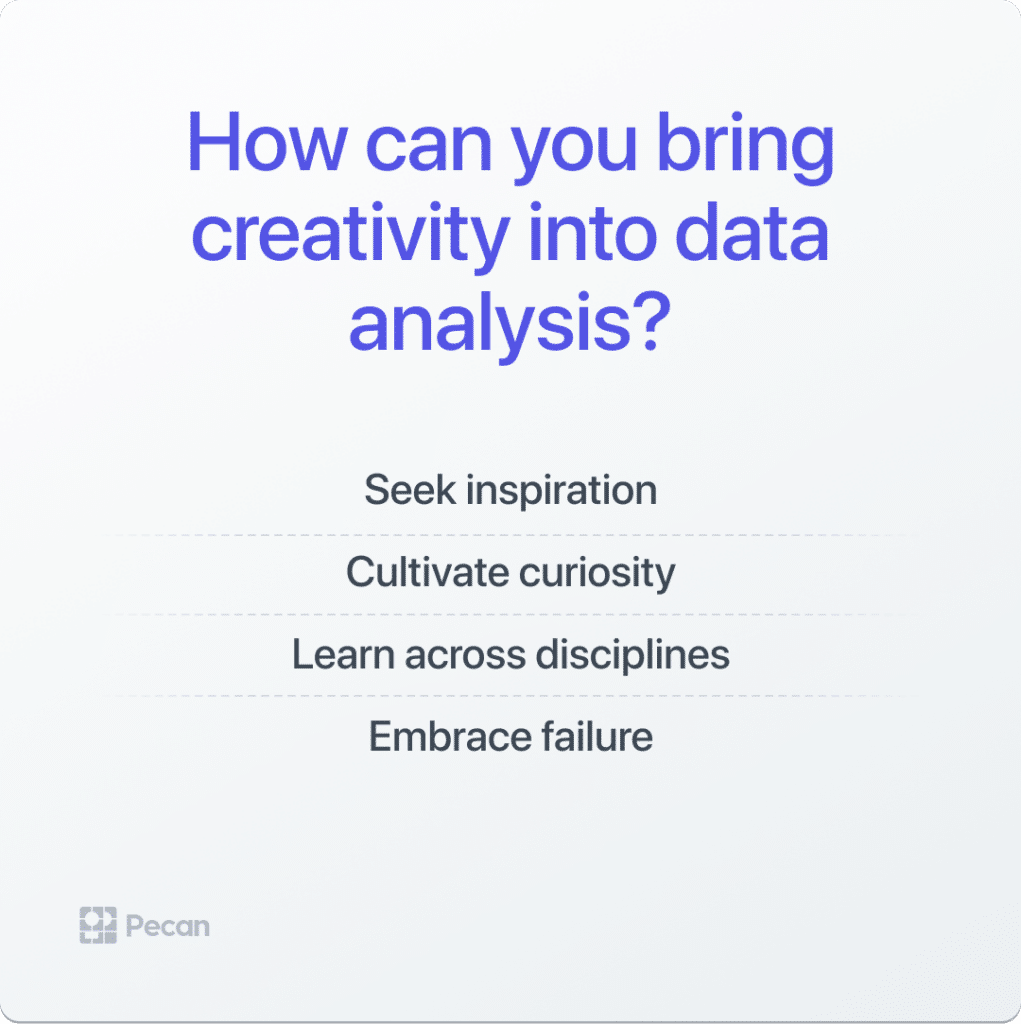In a nutshell:
- Creativity is essential for data analysts to excel in their roles and drive innovation.
- Developing creativity involves using idea-generation techniques, seeking inspiration from podcasts, cultivating a curious mindset, engaging in cross-disciplinary learning, and embracing failure.
- Bringing creativity into data analysis involves diversifying skill sets, reading case studies, asking the right business questions, collaborating and communicating effectively, and staying up to date with emerging trends.
- By harnessing creativity, data analysts can explore new ways to approach tasks, gain insights, and deliver accurate predictions that contribute to their company's success.
Imagine, if you will, a data analyst whose mind operates at an extremely high level – crunching numbers and extracting insights with an unmatched level of precision. Colleagues marvel at their ability to bring order to chaos and to produce flawless reports.
Then, imagine, a few cubicles away, a data analyst with a flair for the unconventional. Their desk is adorned with a kaleidoscope of sticky notes and comic book characters. And while they’re proficient at working with statistical formulas and delivering insights, they tend to infuse their work with a spark of innovation.
Who would you consult if you had an important business challenge that needed to be solved?
Many people would go with “The Logical Maestro,” who will be able to deliver highly accurate results in minimal time – just what the boss ordered. But others might go with “The Dreamweaver of Data,” who is more likely to come up with out-of-the-box ideas that address your challenge, whether you like it or not.
For example, while the first analyst may immediately focus on the data you have, the second analyst may first consider the data you don’t have but can possibly get. In some cases, the creative data analyst will not only meet expectations but also have a great chance of beating them.
-

- Creativity is key for data analysts
So what’s the point of our little story? As a data analyst, you can amplify your impact by harnessing the power of creativity.
Creativity is not just the domain of writers and designers. It has a pivotal role to play in the field of data analytics, from problem-solving and visualization to data exploration and communication.
In this blog post, we’ll explore how creative thinking can enhance the data analysis process, open doors to innovative solutions, and help you extract insights that go beyond the expected. And we’ll share some ways that you can tap into your creative side.
Ready?
What is creativity?
Many professionals are disenchanted with their jobs. This is often because they find their work repetitive, not challenging enough, or too stressful. But just as quickly as these types of situations can emerge, they can also be resolved.
One source of the problem? We office-dwellers (or home office-dwellers) are often held back by a blind spot that obscures our potential to grow and improve the status quo.
By simply accepting things as they are (yet often complaining about them), we fail to grasp new opportunities to grow within our role, discover more efficient ways to do things (especially grunt work), and proactively improve our workplace situation. All it calls for is some creativity.
At its core, creativity is the ability to generate novel ideas and solutions. It’s expressed in many different ways, and although it’s typically associated with domains like art, film, advertising, and entrepreneurship, it infiltrates every profession and industry.
And in the world of technology, it’s the spark that ignites innovation and propels progress.
How can you develop creativity?
As a professional, tapping into your creative side can lead to the development of new and better ways of approaching tasks and previously unexplored ideas, insights, and solutions. By keeping an open mind and viewing things in a new light, you might even rekindle your passion for your job, employer, or profession.
The question is … how can you unlock your creative potential and leverage it effectively in your role? To answer that, let’s take a look at some strategies, resources, and actionable steps you can take:
Use idea-generation techniques
The ability to come up with original ideas is valuable in any profession, and it’s often what sets top contributors apart. Fortunately, this skill is something that can be strengthened and improved over time. “7 Creative Idea Generation Methods” is a great little article that presents different techniques for generating innovative ideas.
From brainstorming and mind-mapping to role-playing and reverse thinking, these methods can spark fresh perspectives on what you already know to be true and ignite your creative thinking.
By incorporating one or more of these ideas into your problem-solving processes, you’ll find it easier to break free from convention (or whatever has been holding you back) and discover new possibilities
Seek inspiration from podcasts
Podcasts have emerged as a rich source of inspiration and knowledge across various domains. Whether you’re looking for career-related insights, ideas for professional growth, updates about tech innovation and AI, or inspiration to tap into your passion and creativity, there is a podcast out there for you.
Because there are so many—each with its own particular approach and expert host—we recommend that you simply go to wherever you get your podcasts and start searching.
Cultivate a curious mindset
Cultivating a curious mindset is essential for nurturing creativity. One may argue that it’s also crucial for becoming empathetic, communicative, and successful in anything you pursue.
Whether you’re an experienced manager or a recent graduate, try to embrace a sense of wonder and inquire into the world around you. Ask questions, challenge assumptions, and explore different perspectives. Be humble and recognize that other people will always have a unique viewpoint and new information to offer.
By adopting a curious approach, you open yourself up to new experiences and ideas, fueling your creative endeavors.
Engage in cross-disciplinary learning
You’ve probably heard the phrase, “Jack of all trades, master of none,” which implies that it’s better to have a broad range of skills and knowledge than to become an expert in one specific field.
While it’s true that there is a tradeoff between breadth and depth of knowledge, we would still encourage you to become an expert in at least one domain. That being said, being versatile and having a diverse skill set can be very advantageous in your life and career as you attempt to navigate different situations and adapt to various challenges.
Take every opportunity to expand your knowledge beyond the boundaries of your domain. Explore subjects outside your comfort zone, attend workshops or webinars on topics that are relevant or simply interest you, and collaborate with professionals from other disciplines.
Engaging in this type of cross-disciplinary learning will expose you to different perspectives and methodologies. More importantly, it will lead to a cross-pollination of ideas that inspires creative thinking and innovation.
After all, what scriptwriter would have been able to come up with “Breaking Bad” without some knowledge of organic chemistry and the criminal underworld?
Embrace failure
Creativity thrives in an environment that embraces experimentation and allows room for failure. Not every idea will succeed, but every failure holds a valuable lesson.
So be sure to embrace the learning opportunity that comes with any setback, and use it to refine your approach, explore alternative paths, and pursue continuous growth.
Although we can’t all “move fast and break things,” there should always be an occasional opportunity to pursue a new, radical or risky idea (so long as it doesn’t get you fired!).
Be honest with yourself and transparent with others, and your colleagues will generally support you. Then, you will be on your way to creating a data-driven culture.
-

- Photo by Airfocus on Unsplash
How can you bring creativity into data analysis?
Embracing creative thinking as a data analyst can power your career in many new and unexpected ways. After all, just one unique idea can lead you to explore a dataset in a new way or identify a pattern that may have eluded conventional analysis.
In the above section, we covered some general techniques that will help you develop your creativity. Here, we’ll touch on some ideas as they apply specifically to data analysis.
- Diversify your skill set: By expanding your knowledge beyond traditional data analysis techniques, you can explore new ways to transform and gain insights from your data. There are countless resources out there to help you learn about tools, concepts, programming languages, and methodologies that will enhance your analytical capabilities. One strategy that’s likely to profoundly impact your career is predictive analytics with AutoML.
- Read case studies: In “What Does It Mean to Be Creative as a Data Scientist?,” the author stresses the idea of reading data analysis case studies, which provide direct insight into the many ways that organizations are implementing analytics, statistics, and AI. By learning about the challenges others are having and how they’re dealing with them, you can gain insights that can be directly applied to your work, or that inspire you to explore problems or opportunities you never even realized existed.
- Ask the right business questions: It is the creative data analyst who will discover new problems to solve and new ways to realize value from their data. One way they do this is by gaining an understanding of their company’s goals and challenges, as well as the industry it operates in. Such an analyst will also think beyond the obvious and ask counterintuitive questions like, “Which previously held assumptions are the ripest for testing?”
- By crafting a good hypothesis and seeking answers that would be meaningful to your business, you can enhance your value and impact. So make it a priority to develop business questions that have the potential to move the needle. You might focus on KPIs like churn, customer lifetime value, or call-center efficiency. To make this easier, Pecan's Predictive GenAI allows you to ask and customize your tailored predictive model — all through a natural-language chat.
- Collaborate and communicate: One of the best ways to stimulate creativity within your role is by collaborating with others and honing the way you communicate insights. Be sure to engage in discussions with not only your coworkers but also colleagues in other domains so you can exchange ideas, experiences, perspectives, and approaches. While you’re at it, explore new ways to communicate insights, whether in regards to how you visualize data, or how you build arguments to convince management of the value of your insights.
- Stay up to date with emerging trends: Being aware of new tools, technologies, and methodologies can spark fresh ideas and an innovative approach to your work. So get a constant dose of inspiration by keeping up with the latest developments and trends in data analysis, advanced analytics, and AI. You can attend conferences, webinars, and workshops, or simply follow industry blogs and thought leaders on LinkedIn. A good branching-off point might be the TLDR newsletter, which provides a daily 5-minute roundup of interesting stories in startups, tech, and programming.
Ready to challenge the status quo, push the boundaries of what’s possible, and amplify your impact as a data analyst?
Sign up for a free Pecan trial and discover our innovative approach to data analysis.
By embracing the ease and efficiency of AI-powered predictive models, you can make the shift from hindsight to foresight, set out to answer high-impact business questions, and deliver accurate predictions that contribute directly to your company’s bottom line.





